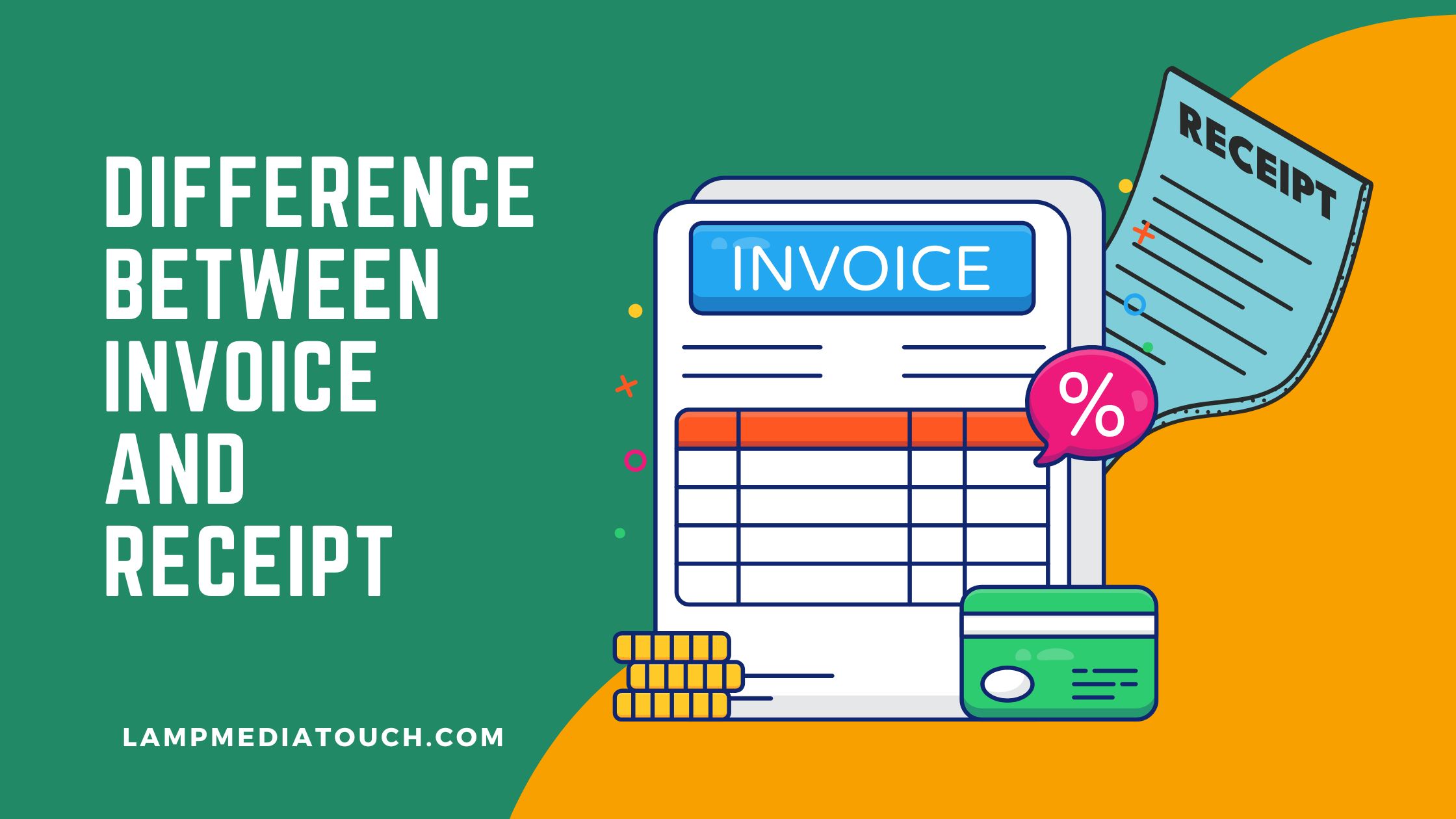When running a business, understanding the difference between an invoice and a receipt is crucial for maintaining proper financial records and ensuring smooth operations. Many business owners, especially new ones, often confuse these two essential documents. While both invoices and receipts are related to business transactions, they serve different purposes and are used at different stages of a transaction. This article will explain the differences between an invoice and a receipt, emphasizing their importance to business operations, especially in the Nigerian context.
Introduction to the Confusion: Invoice vs. Receipt
For many business owners and customers alike, the terms “invoice” and “receipt” are often used interchangeably, causing confusion and sometimes miscommunication. Although they are both financial documents, understanding when to issue each is crucial to the overall financial health of a business.
Imagine a scenario: you purchase goods from a local supplier, and at the end of the transaction, they hand you a document. Is it an invoice? Or is it a receipt? You need to know this distinction, especially if you are managing your own finances or need documentation for tax purposes. The inability to differentiate between the two can lead to miscalculations, poor record-keeping, and potential legal troubles with tax authorities.
Importance of Proper Documentation for Businesses
Invoices and receipts are more than just pieces of paper. They are vital tools for running a successful business in Nigeria, especially in a country where many businesses still operate primarily on paper-based systems for documentation. Whether you’re in retail, manufacturing, or service delivery, understanding how and when to use these documents is essential.
Failure to issue a proper invoice or receipt can lead to a misunderstanding of financial agreements, loss of income, or even difficulties with the Federal Inland Revenue Service (FIRS) during tax time. For business owners, ensuring that both documents are correctly issued not only enhances professionalism but also safeguards against fraud and disputes.
What is an Invoice?
Definition and Purpose
An invoice is a formal document that a seller sends to a buyer, outlining the details of a sale and requesting payment for goods or services provided. It lists the items sold, their quantities, unit prices, total amounts, taxes (if applicable), and any other charges. Essentially, it is a demand for payment.
Invoices are common in business transactions, especially in sectors like wholesale, manufacturing, and services. Typically, an invoice will include:
- Seller’s Information: Name, address, and contact details of the supplier.
- Buyer’s Information: Name and address of the customer or client.
- Itemized List of Goods/Services: Description, quantity, unit price, and total price.
- Payment Terms: Payment due date, acceptable payment methods, and any discounts for early payment.
- Tax Information (optional): In cases where VAT or other taxes apply, they are clearly mentioned.
When is an Invoice Issued?
An invoice is issued before the payment is made. The supplier sends the invoice to the customer either upon delivery of goods or after providing a service, with the expectation that the buyer will settle the amount within a specified period (often referred to as net 30 or net 60 days).
In Nigeria, invoices are often printed in multiple copies, with one copy given to the buyer and the seller retaining another copy for their records. This helps maintain accountability and track pending payments, which is essential for financial management, especially when dealing with clients who request credit terms.
What is a Receipt?
Definition and Purpose
A receipt, on the other hand, is a document that acknowledges that payment has been received for goods or services. It serves as proof that a transaction has been completed. While an invoice is a request for payment, a receipt is confirmation that the payment has been made.
A typical Nigerian receipt includes:
- Receipt Number: A unique number for tracking the transaction.
- Seller’s Information: The name, address, and contact details of the seller or business.
- Buyer’s Information: The name of the customer who made the payment.
- Amount Paid: The total amount received, including taxes, if applicable.
- Date of Payment: The date when the payment was made.
- Payment Method: Whether the payment was made via cash, bank transfer, or any other method.
When is a Receipt Issued?
A receipt is issued after the payment has been made. In most businesses, once the customer has paid for the goods or services, they are handed a receipt to confirm the transaction. Like invoices, receipts are typically printed in multiple copies, with one copy for the customer and another for the seller’s records.
Receipts are crucial for both parties involved in the transaction. For the customer, it serves as evidence of purchase and is often needed for future claims, such as product returns, warranty claims, or tax deductions. For the business, it is proof that income has been generated and can be useful for bookkeeping, auditing, and tax filing.
Key Differences Between Invoice and Receipt
In many parts of the world, there’s a strict sequence: the invoice comes first, then payment, and finally, a receipt. However, with small and informal businesses, this sequence can be more flexible.
- Timing: An invoice is issued before payment, while a receipt is issued after payment.
- Purpose: An invoice requests payment; a receipt confirms payment has been made.
- Document Format: Invoices usually include detailed payment terms, item descriptions, and totals. Receipts primarily focus on the amount paid and the method of payment.
- Tax Compliance: Both documents are important for tax purposes, but invoices are typically used to calculate VAT or other taxes, whereas receipts are proof that the transaction has been settled.
Real-World Nigerian Business Practices
In Nigeria, especially among small businesses, the traditional sequence of issuing invoice and receipt can be a bit more fluid. In many cases, invoices are written at the same time as the payment is being processed. This means that once the buyer and seller agree on the amount, the seller starts writing the invoice while the buyer prepares to make the payment. This simultaneous process helps facilitate fast transactions, especially in local markets, retail shops, and informal business environments.
Unlike more formal business settings where invoices are strictly issued before payment, Nigerian businesses often treat invoices as both a payment request and confirmation of the transaction in real time. This flexible approach works well in fast-paced environments where time and efficiency are key.
Importance of Invoice and Receipt in Nigerian Business Operations
1. Financial Clarity
In a cash-driven economy like Nigeria, clear financial documentation is critical for both business owners and customers. Properly issued invoices ensure that businesses are paid for their services, while receipts confirm that payments have been received. This helps businesses maintain transparent financial records, which are vital for budgeting, auditing, and tax reporting.
2. Legal and Tax Compliance
For businesses in Nigeria, both invoice and receipt are essential for complying with tax laws. The Federal Inland Revenue Service (FIRS) requires businesses to maintain accurate records of sales and payments. Invoices help calculate the correct amount of VAT, while receipts confirm that transactions have been completed and payments made. Proper documentation also protects businesses from potential disputes with customers or tax authorities.
3. Professionalism
Issuing invoices and receipts adds a layer of professionalism to your business. It shows that you are organized and capable of managing transactions efficiently. For customers, receiving both an invoice and a receipt reinforces trust, knowing that they are dealing with a reputable and accountable business.
Conclusion: Streamlining Your Business with Proper Documentation using invoice and receipt
Understanding the difference between invoice and receipt is essential for every business in Nigeria. These documents are not just administrative paperwork; they are critical tools that help you manage your finances, ensure compliance with tax laws, and build trust with your customers. By issuing invoices and receipts at the appropriate stages of your transactions, you can safeguard your business from financial errors and improve your overall efficiency.
Call to Action
If you need high-quality printing of invoice and receipt that align with your business standards, look no further than LampMediaTouch. We specialize in providing professional, durable, and customizable print solutions for all your business needs. Whether you require carbon copy invoices or receipt books, we are ready to deliver top-notch prints that enhance your business operations. Contact LampMediaTouch today for quality prints that elevate your business!




